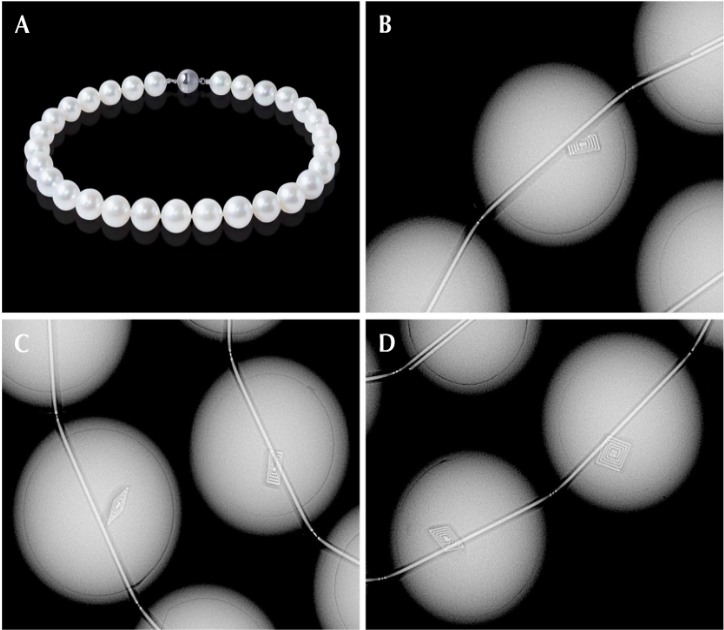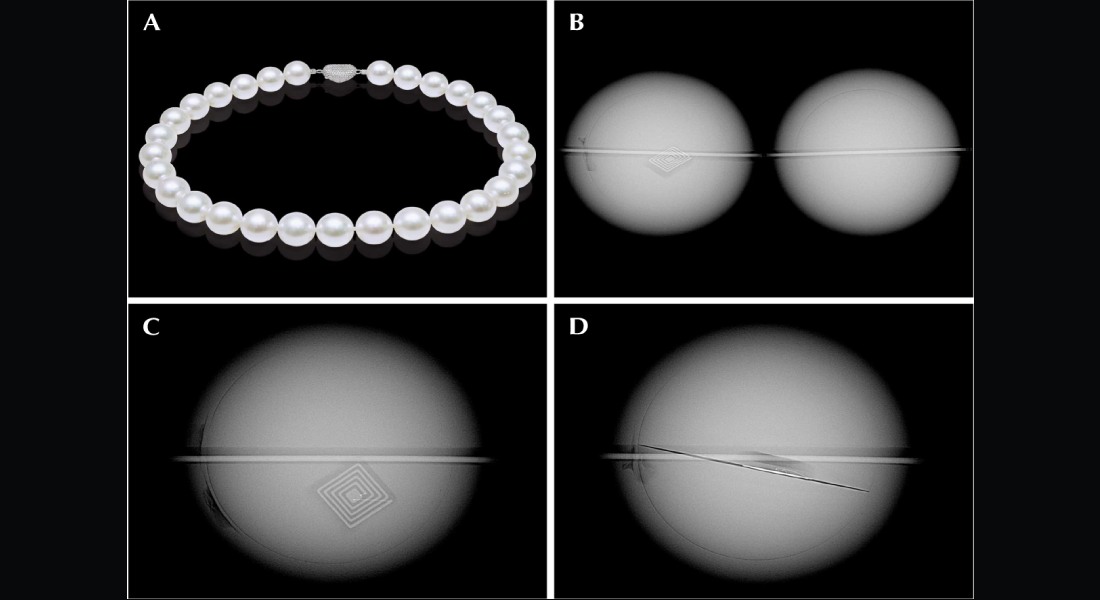New technologies are increasingly being applied to cultured pearls, and it is exciting to witness developments in pearl traceability. GIA’s Bangkok laboratory recently received two South Sea bead cultured pearl necklaces, each consisting of 29 pearls ranging from 14.80 to 15.90 mm in diameter (strand A, figure 1A) and 14.40 × 14.20 mm to 16.20 mm in diameter (strand B, figure 2A). General observation under a binocular microscope revealed clear aragonite platelets characteristic of nacreous pearls, with no indications of treatment.

Real-time microradiography (RTX) revealed obvious demarcation features separating the shell bead nucleus from the overlying nacre layers. The nacre thickness range was consistent with bead cultured pearls produced by the Pinctada maxima mollusk (N. Sturman et al., “Bead cultured and non-bead cultured pearls from Lombok, Indonesia,” Fall 2016 G&G, pp. 288–297). However, the most striking feature was the presence of some electronic components within a few of the pearls. They were visible as opaque white squares with a stepped pattern in keeping with previously examined samples containing radio-frequency identification (RFID) devices (H.A. Hänni and L.E. Cartier, “Tracing cultured pearls from farm to consumer: A review of potential methods and solutions,” Journal of Gemmology, Vol. 33, No. 7-8, 2013, pp. 239–246; Spring 2020 Lab Notes, pp. 134–136). Interestingly, only a single pearl in strand A (figure 1, B–D) and five pearls in strand B (figure 2, B–D) contained an RFID device. The device is usually positioned off the center of the bead to avoid being drilled.

GIA’s Hong Kong lab has also begun seeing similar features in recent submissions (figure 3, A–B). The team compared the RTX data with some known bead cultured pearls containing an RFID device (figure 3, C–D) and confirmed that they were identical. The previous studies mentioned earlier describing RFID devices in bead cultured pearls have shown that these nuclei are produced by a patented pearl technology invented by Fukui Shell Nucleus Factory, which also supplies laminated beads to certain pearl farms. This explains the link between the laminating technique and its application in the production of RFID shell beads.
The use of RFID shell beads is known to assist in the storage of certain data such as a pearl farm’s location, mollusk data, and harvest date. However, a specific RFID reader is required to retrieve the data, so we were unable to obtain the information stored within these particular devices. Since the RFID devices do not influence their external appearance, the pearls containing a shell bead nucleus with such components are still identified as bead cultured pearls. Because the RFID device could increase the weight and have a misleading effect if undetected, a special comment is routinely included on GIA pearl identification reports as a means of disclosure. While pearl tracing technology has not been extensively adopted by the cultured pearl industry, the increasing number of electronic devices in shell bead nuclei submitted to the laboratory is noteworthy. GIA will continue to monitor and provide updates to the pearl trade and consumers.
This article is republished with permission from the Gemological Institute of America (GIA).

